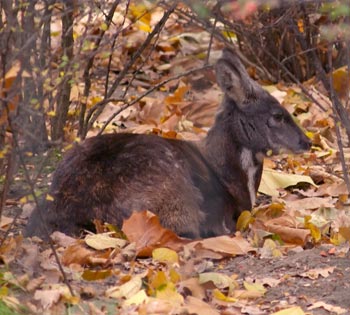At one time, musk came almost exclusively from various species of Musk Deer but this has almost entirely disappeared from use for ethical and cost reasons.
 |
| Moschus moschiferus - one of the species that were the original source of musk |
Most fragrances now use some form of synthetic musk, but there are a few natural sources still sometimes used. In particular ambrette seed oil (containing the chemical widely used in synthetic form as ambrettolide) and angelica root oil (now known to contain the chemical exaltolide, though this was not recognised until long after exaltolide had been made synthetically).
Some synthetic musks are crystalline solids and as a result are often sold either pre-diluted or ‘mobilised’ in something to make them liquid and easier to handle.
There are a huge number of musks on the market, these are some of those I use particularly like or find useful:
Ambrettolide this synthetic is the same as the musk in Ambrette Seeds - a very good quality diffusive musk, slightly fruity, very smooth and exalting.
Applelide an IFF product, this is relatively short-lived for a musk but has a strong, velvety top-note that give a great deal of richness and has a fruity aspect of apples as well.
Cashmeran also from IFF is interesting - liquid and easy to handle - has a spicy quality. When used successfully it is very warming and velvety. Not everyone considers this molecule as a musk at all.
Celestolide crystals that are slow to dissolve in ethanol. Adds more brightness than the others, very good diffusion.
Civettone isn't widely used alone or available in small amounts. It is the musk component of natural civet paste and the synthesised version is used as part of civet recreations, arguably the most powerful fixative in perfumery.
Ethylene brassylate (also called Musk T), widely available, liquid at room temp and cheap, good fixative properties and easy to use macrocyclic musk.
Exaltolide solid at room temp but melts easily, very widely available and used macrocyclic musk with a fairly strong, sweet-musk aroma. Not everyone can smell exaltolide but it's one of the finest musks you can use.
Exaltone is the key molecule in muskrat musk and although it can now be synthesised even the synthetic version is very expensive. It is however incredibly persistent and, arguably, one of the best fixatives known to perfumery. More animal smelling than most synthetic musk.
Galaxolide a polycyclic musk, very widely available and used, especially in functional products. Often sold as 50% in DEP or IPM as it’s so thick a liquid as to be virtually solid otherwise. A polycyclic musk which is not biodegradable and very persistent in the environment and people.
Habanolide a macrocyclic musk from Firmenich with a strong odour and slightly waxy and metallic freshness.
Helvetolide another Firmenich product, this is unusual in having a strong top-note as well as the more usual persistence of musks. It also has a fruity aspect of pears.
Muscenone is one of the components of natural deer musk, very good fixative and diffusive qualities and has a stronger musky smell than the better-known muscone:
Muscone this is the main musk that is in musk deer pods but synthesised. Lovely fine musk that has the edge over the others for its erogenic quality l-Muscone is a more expensive and even finer quality - just the L isomer. Both forms have a nice powdery quality.
Romandolide not so widely available, similar in scent to Galaxolide but alicyclic (or linear) and biodegradable: very useful and I'm in the process of phasing out galaxolide to be replaced by romandolide in all my retail range.
Tonalid polycyclic, crystalline solid again but a bit easier to dissolve than some. Often disparagingly referred to as ‘laundry musk’ it’s nevertheless a good fixative and very widely used. Cheap enough for functional products and gives a very clean effect.
Velvione another macrocyclic, very fine musk of great diffusion, rather like ambrettolide but less fruity and even softer. A great exalting agent, it has little scent of it's own but has a big effect in a blend and gives a distinct powdery effect.
There are plenty of others. I nearly always use musks in combination rather than using just one in a composition. In particular you can get good effects by using very tiny amounts of ambrettolide or velvione alongside one of the cheaper musks. Both work well with Exaltolide and Romandolide.
Another option is Auratouch from Givaudan - a blend of several of their musk products which I believe also includes a captive.
Synthetic musks have also been the cause of some controversy and a number of them were found to be unstable, carcinogenic or environmentally damaging.
Musk Ambrette is prohibited by IFRA and Musk Ketone is banned in some countries even though it isn't restricted by IFRA. Musk Xylene is banned throughout the EU and prohibited by IFRA.
 |
| Muscone, a macrocyclic musk |
If you want to understand the different categories of musk (based on their chemical structure) and something of the history of their production the Wikipedia article on Synthetic Musks makes excellent reading.

Wonderful blog & good post.Its really helpful for me, awaiting for more new post. Keep Blogging!
ReplyDeleteBakhoor Oud Attar Online
This is very useful to me...
ReplyDeleteAhsan attar Perfume India